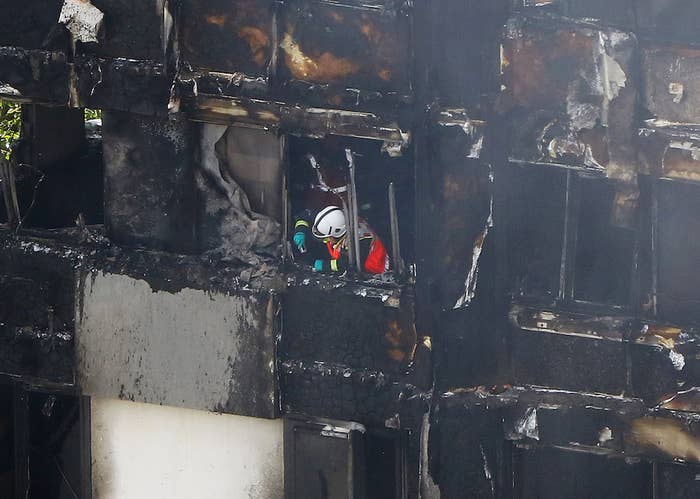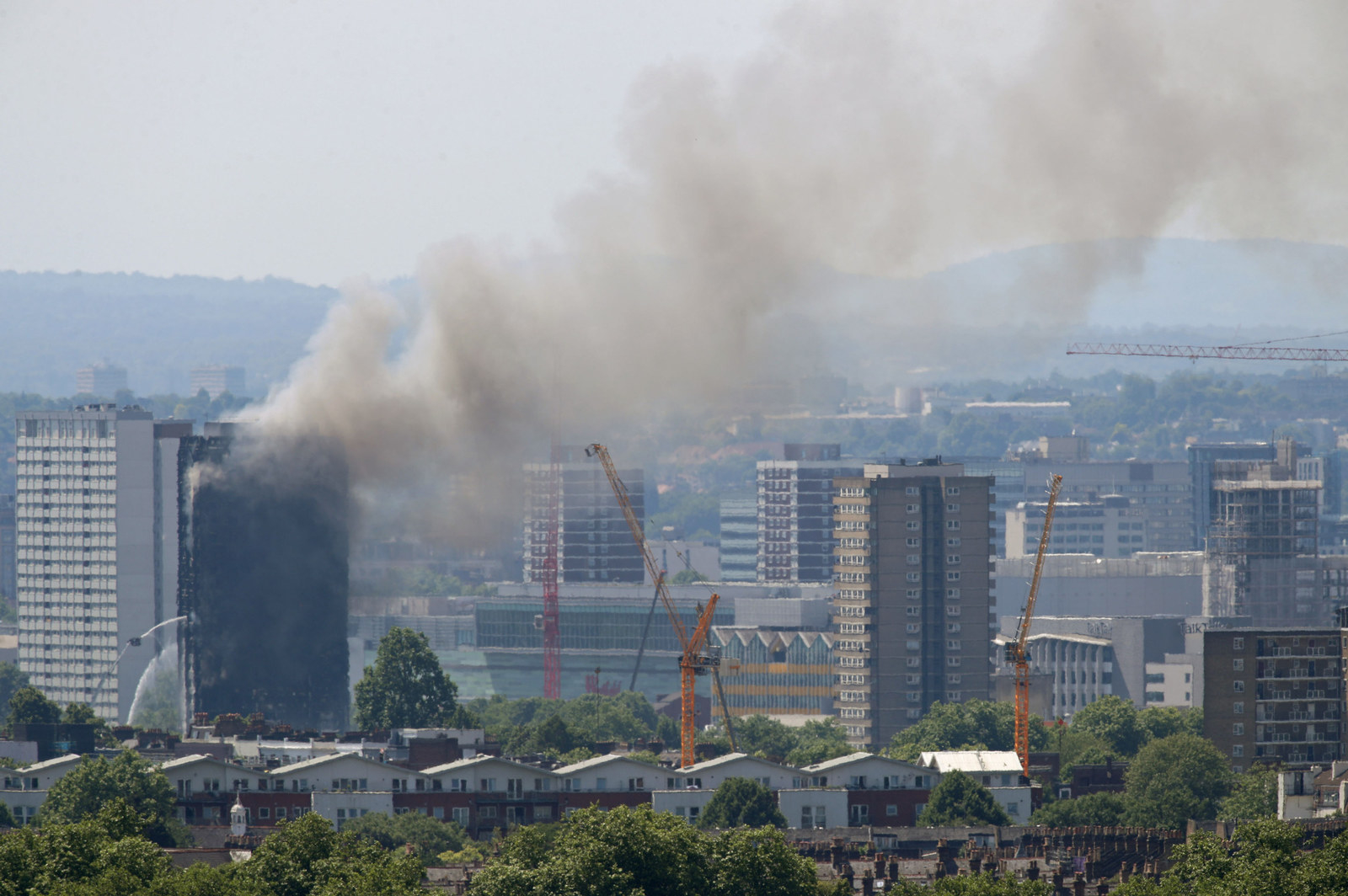
A major investigation will take place to examine the cause of the Grenfell Tower blaze on Wednesday, in which at least six people died, and to determine how it spread with such speed and ferocity throughout the building.
Addressing the media on Wednesday afternoon, London Fire Brigade commissioner Dany Cotton said: "As you will appreciate, this is a completely unprecedented fire. In my 29 years in the London Fire Brigade, I have never seen a fire of this nature, and I have seen many high-rise fires.
"This will of course be subject to a major investigation, but at this moment in time we do not wish to speculate further about the cause of the fire, or the fire’s spread. That is something that will be closely looked at in the very near future."
The Kensington and Chelsea Tenant Management Organisation (KCTMO), which manages the Grenfell Tower, said in a statement that it's too early to speculate on what may have caused the fire, and that it was cooperating fully with investigators "to ascertain the cause of this tragedy."
A resident who escaped the tower in the early stages of the blaze has described seeing the entire side of the building “go like a matchstick” as the cladding caught fire.
The unnamed man, who left with nothing but his phone and the clothes he was wearing, told a reporter: "I had to really pull myself out to look from the window on the 17th floor, and I see this fire blazing and coming up really fast because of the cladding – the cladding was flammable, it was going up like a matchstick.
“As soon as we came outside, the whole building on side all the way to the top was on fire, as if the cladding caught fire and went straight to the top. How can you put this out when the length of the building is now on fire?"
This man managed to escape from the 17th floor with his 68-year-old aunt. He told me how he got out #LatimerRoad
The investigation is set to focus on the role the recent refurbishment may have played in the the speed with which the fire spread.
A resident who escaped the blaze but declined to provide their name told BuzzFeed News: "They've redone the building and everyone was complaining about the insulation. When the building was burning a lot of insulation was flying out. If it wasn't for that insulation that building wouldn't have lit up like that."
Analysis of planning documents by BuzzFeed News has found that the cladding used in the Grenfell refurbishment was changed during the planning process to a type of material that had been used in other tower blocks that suffered fires.
In the original planning application, submitted on October 2012, zinc rainscreen cladding was listed alongside Celotex FR5000, a type of insulation which has high fire resistance.
On 10 January 2014, the application was approved, provided the developer provided drawings and samples of the materials it planned to use.
Then, in a new submission on 30 September 2014, the material had changed to aluminium composite material (ACM) panels, the same category of cladding present in a long list of tower block fires. ACM is composed of an insulation layer sandwiched between two thin sheets of aluminium.
Planning documents suggest that the Reynobond brand of ACM was proposed for use, which is available in with either a polyethylene core or a fire-resistant core. The documents reviewed by BuzzFeed News did not indicate which type was used, but on Wednesday night BBC Newsnight reported that it was the less fire-resistant polyethylene option.
We have worked out cladding on the building *was* Reynobond cladding with a polyethylene core –less fireproof of 2 Reynobond products. (1/4)
The Sydney Morning Herald pointed out after the Grenfell fire broke out on Wednesday that ACM cladding was present in almost a dozen tower blocks that suffered fires around the world in the last decade, including one in Melbourne in 2014 and one in France in 2012.
The Grenfell case has echoes of the Lakanal House disaster in Southwark, south London, in 2009, in which six people died including three children. In that fire, cladding caught alight within four and a half minutes.
Sam Webb, a fire safety expert who acted as an expert witness at the Lakanal families’ inquest, told the Architects Journal: “This tragedy was entirely predictable, sadly. What we saw at Lakanal House should have been enough to make people think about what was going on with the outside of our buildings in terms of cladding.”
A House of Commons inquiry in 1999, prompted by a tower block fire in Irvine, Ayrshire, warned that the level of testing the industry was carrying out was not adequate. “We do not believe that it should take a serious fire in which many people are killed before all reasonable steps are taken towards minimising the risks,” its report said.
The company that installed the Grenfell Tower cladding, Harley Curtain Wall, said in an online case study on its website – now deleted but available via Archive.org’s cache – that it used “ACM rain screen over-clad” as part of a contract worth £2.6 million. These details will be pored over by investigators looking for clues as to how and why the blaze wasn’t contained in the flat in which it started.
Harley Curtain Wall was put into liquidation in 2015 and made 11 staff redundant, after it had completed its Grenfell and before its assets were sold to Harley Facades, a company run by a former Harley Curtain Wall director.
In a statement, Ray Bailey, managing director of Harley Facades, said: "This is an incredibly tragic incident. Our thoughts are with the residents and their families who have suffered such a personal loss. We will fully support and cooperate with the investigations into this fire.
"There will be many questions about this whole incident and so you will appreciate that it would not be appropriate for us to comment or for others to speculate on any aspect of the fire or its causes in advance of these inquiries. At this time, we are not aware of any link between the fire and the exterior cladding of the tower."
Nick Padget-Brown, the leader of Kensington and Chelsea council, told a press conference on Wednesday night: "Clearly looking further ahead there needs to be a full investigation as to the cause of this fire, why it started and why it appears to have spread so rapidly. That is a matter for a full investigation which the council will fully support.
"It is true that the tower underwent a major refurbishment programme starting about two and half years ago to improve the heating, to improve the hot water, to improve the windows and put in new insulation and external cladding, to improve quality of life for people who were living there.
"We will need to look much more closely into how much the corresponds to the cause of today’s fire.”
It also emerged on Wednesday that the tower had not received an official fire risk assessment (FRA) in the last 18 months, according to a document released by Kensington and Chelsea council after a Freedom of Information Act request from Inside Housing. The document said Grenfell's last FRA was in December 2015, after the building received new aluminium cladding as part of a multimillion-pound refurbishment project.
Of the 82 towers that the Kensington and Chelsea Tenant Management Organisation manages on behalf of the council, 23 have also not received a FRA for the last 18 months or longer.
Judith Blakeman, a local councillor, told the Today programme on Wednesday morning that the tower was visited by the fire brigade in June 2016 and declared safe.
The BBC reported that the tower received an FRA in June 2016, but this visit was not mentioned in the council's document.

Mark Coles, head of technical regulations at the Institution of Engineering and Technology, which sets helps standards for electrical installations in the UK, said the investigation into the blaze would look at why it wasn't contained in individual flats and was instead able to spread across the entire building.
"In a multi-occupancy high-rise building such as this, any fire which starts should be sufficiently retained for a period of time within that residential dwelling," he said.
"The intent at the design stage of this building was such that the staircases were not intended to be used as a mass escape route. The advice given to residents was that, in the event of a fire, the occupants should remain in their properties. The speed at which this fire spread would suggest that there has been a serious failure in the design and installation techniques employed."
Residents’ groups have repeatedly raised questions about fire safety regulations and provisions in the building.
In its statement, KCTMO said it was aware that "concerns have been raised historically by residents," and that they will "form part of our forthcoming investigations."
The company that carried out the major refurbishment of the tower, which was competed last summer, said it was shocked by the disaster and that all the work carried out met fire and safety standards.
East Sussex-based contractor Rydon said in a statement on Wednesday morning: “We are shocked to hear of the devastating fire at Grenfell Tower and our immediate thoughts are with those that have been affected by the incident, their families, relatives and friends.
"Rydon completed a refurbishment of the building in the summer of 2016 for KCTMO (Kensington and Chelsea Tenant Management Organisation) on behalf of the Council, which met all required building control, fire regulation and health & safety standards. We will cooperate with the relevant authorities and emergency services and fully support their enquiries into the causes of this fire at the appropriate time."
A spokesperson for Kensington and Chelsea council said in an emailed statement: "We are providing emergency accommodation for those affected by today's fire at Grenfell Tower. Our immediate priority is to accommodate the residents of Grenfell Tower, families with young children, the elderly and the vulnerable. For those unable to return to their homes in the surrounding area a rest centre has been set up at Westway Sports Centre.
"We are still placing households and housing officers will work throughout the night to provide assistance and support.
"We have heard a number of theories about the cause of the fire at Grenfell Tower. All of these will be thoroughly investigated as part of the formal investigation which has already begun."
Additional reporting by Hannah Al-Othman.


